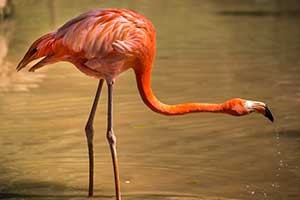Between all of the birds, fish, and reptiles that can be found within the Florida Everglades, it is certainly a very colorful place. But have you ever wondered why some species are more colorful than others, or why there is so much variation within species sometimes? For instance, have you ever wondered why some flamingoes are a pale, soothing shade of pink while others are bright and in-your-face magenta? While genetics and certain hereditary factors certainly come into play within species, surprisingly, so can something as simple as an animal’s diet.
While flamingoes might be the most notable creature that gets coloring from its diet, certain fish, like salmon and koi, are also affected. What causes this phenomenon in certain animals is the presence of something called carotenoids, which are pigments found in plants and other photosynthetic organisms.
When certain birds and fish eat plants and algae that contain these carotenoids, although the plant matter itself is blue-green, it is broken down into orange and pink pigments inside of the animal’s liver, thus giving the animal a bold and pink hue as the more carotenoids it consumes.
Along with the carotenoids, animals tend to absorb the coloring of whatever foods are consumed along with the algae – flamingoes turn such a vibrant pink because they eat shrimp and other crustaceans, for example. This can actually occur in humans as well. You may have seen people who develop a slight orange tint to their skin after consuming large amounts of carrots and sweet potatoes for long periods of time – this is especially common in newborns and young babies as their skin is lighter and thinner. Some people even swear that eating certain foods can, over time, change their eye color or make their current eye color stand out more brightly.
Unlike plants, animals do not photosynthesize and do not produce carotenoids and must instead obtain them strictly from their diets. Because vibrantly colored animals and food products are more appealing to consumers, some animals, such as koi fish on display or flamingoes kept in zoos, are actually given carotenoid supplements in order to enhance their coloring. You’ll find the same processes performed with farm-raised salmon, in order to get the fish colorful and pink so that they can compete with their wild-caught counterparts in the seafood markets.
Can you imagine a flamingo that was perfectly white instead of a beautiful pink? It’s difficult to picture, but this would be the case if flamingoes simply had different diets or lived in different habitats that had limited access to food high in carotenoids. One thing is for sure – the Florida Everglades would certainly be a different place without all the beautiful and colorful creatures that live there.
To experience the beauty of an Everglades swamp tour for yourself, take an airboat ride through the mangroves with the original airboat tour family. You’ll see animals and plants that you’ll never forget and in every color of the rainbow!







